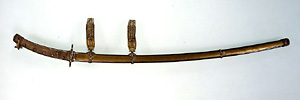I put soil
Is for level ground, and, as preparations for "quenching" to suddenly cool the sword blade which heated with water, serve incineration ground soil (tusk soil) of three kinds of (for patterns on the sword blade) 鎬地用 for blade crests in a sword blade; "put soil", and perform を. I apply a thin coat of incineration ground soil of the level ground use to the level ground uniformly and draw incineration ground soil for blade crests on the blade crest with a writing brush. Finally I pile 鎬地用焼場土 with a ridge from a blade crest thick. Baking it does not enter that much so that the blade side is cooled in immediate cold water by the quenching quickly, and entering, the side of the ridge are comparatively slow, and firing gets cold enough by thickening the incineration ground soil of 鎬地. While a capacity expands by firing, I am tense, and the blade side peculiar to a Japanese sword produces the curve that stuck out. The side of the ridge is have little expansion with steel full of tenacity than the hardness and it is firm, but carries a function to be able to support steel of the fragile blade side.
Quenching
The swordsmith darkens the illumination of the workshop at the time of quenching and usually judges temperature of the steel from the light. I put the sword blade which I put it, and did soil in a firebed deeply and heat the whole from the point to the cause to around 800 degrees Celsius evenly. The temperature of the heating is the most important and ascertains the most suitable heating state with extreme caution, and be depressed to a water tank, and immediate cold water does a sword blade at a stretch. The sword blade produces a curve in water according to the said article, and it is raised after enough cooling, and it is polished in a wild whetstone, and a fried blade is confirmed. The sword blade is warmed to blaze of the charcoal, and "fried return" is performed afterwards. This is work to be called "companion" (I meet and take it). I give a blade moderate flexibility by performing "a companion". Because it occurs in the cross direction a little, I use the mallet with the stand of the tree, and the curve revises it. Is なかごも ware; besides fix the form.
By quenching, a very hard organization called martensite appears on the surface of the sword. I call the thing which I see in the shape of the particle that a pattern on the sword blade is round on the surface of the ground iron by the naked eye by how to enter martensite with 錵 (boiled) or 沸 (boiled) and distinguish a small white thing seen linearly from a smell (a smell) without one one particle being distinguished.
It is other cutlery to turn on firing in oil, and, as well as water, there is it, and it has been performed in the sabers in during the second World War in the case of a Japanese sword, but it seems that it is rare that I put firing in a Japanese sword in oil now to be performed (attention:) The definition of the modern Japanese sword which Ministry of Education, Culture, Sports, Science and Technology establishes is water ware to the last. ) that a gun and sword method becomes illegal as for the oil-hardening. I suddenly cool it and because there is not it, there is little failure such as the running out of blade, but cut it and have it and do not do it when I turn on firing in oil without it is it with a soft steel organization, and it is good, and can cut it. In addition, I become the smell result entirely. Cut it without can give a clearness in a pattern on the sword blade, and the taste is because I am unsuitable for a sword in the present age to intend an art industrial art object as the other (a sharpness rice cake is sorry not to be able to cut it).
Subscribe to:
Post Comments (Atom)

No comments:
Post a Comment